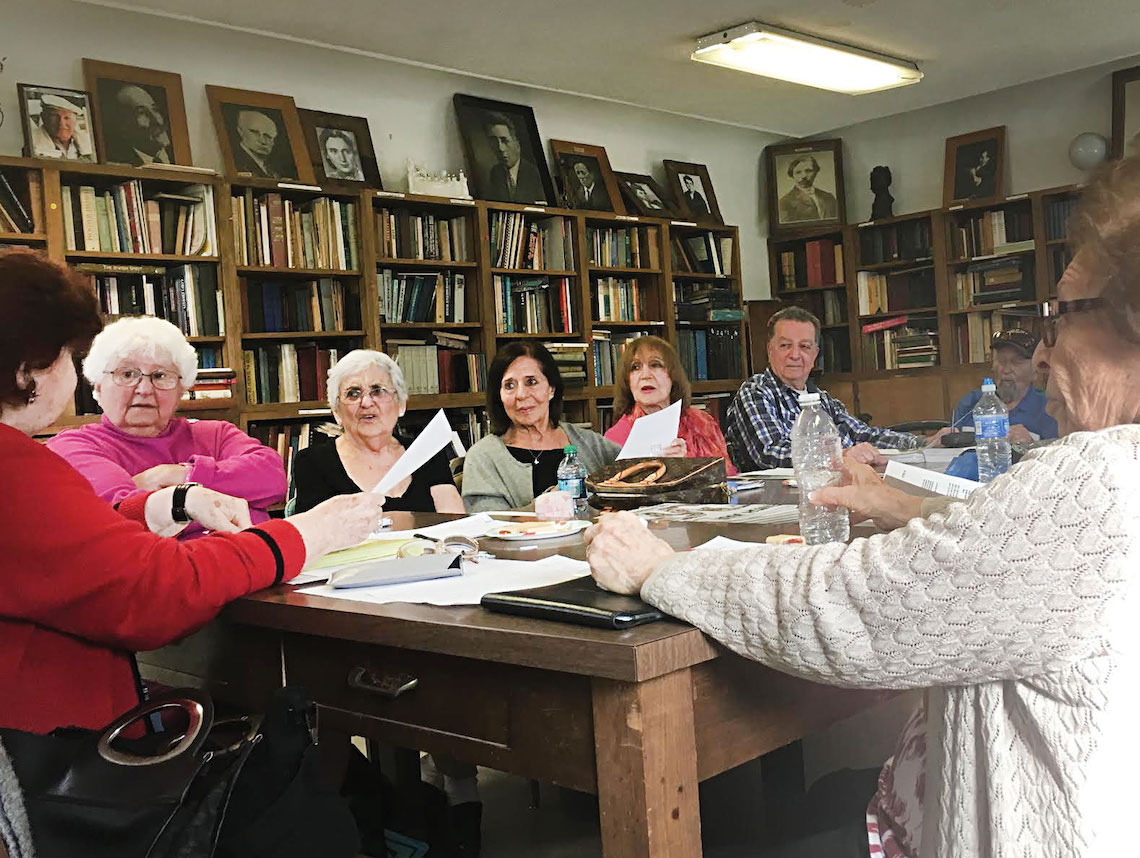
On any given Monday afternoon, the most likely place to find Ben Silver is the Yiddish conversation class at the SoCal Arbeter Ring/Workmen’s Circle, a Jewish cultural and social justice organization near Robertson and Pico boulevards. He’s easy to spot: At 97, he’s usually the oldest student in the room.
At one recent class, Silver was the first to arrive, wearing a “World War II Veteran” baseball cap and carrying a bag of snacks to share with the class. Silver said he grew up speaking Yiddish, but, after years of not using it, “I lost the language.” That is, until a few years ago, when he first found out about the conversational class.
“There was a yearning in me to go back to my roots and to learn all of the goodness that I learned from my family,” he told the Journal. “This brings back a beautiful time in my life.”
Silver sits in a room with a long wooden table at the center and a green chalkboard at the side. He’s one of about 15 students, most of them age 80 or older whose childhood memories of Yiddish have faded over years and assimilation. The weekly 75-minute sessions, taught by Hadasa Cytrynowicz, 82, become a time capsule, with bookcases of dog-eared Yiddish classics lining the walls.
Cytrynowicz fled Poland with her parents in 1939 when Germany invaded their small town. Later, she lived in the Soviet Union, a German displacement camp, a newly formed Israel, Brazil (where she was the first professor at Sao Paulo University to teach Yiddish), and now Los Angeles. She told the Journal that she’s always felt like an outsider. “But I’m at home in the classroom,” she added.
It’s a “home” for her students, as well.
“My parents were both Yiddish speakers, especially when they didn’t want the kids to know what they were talking about, which I think was very common,” said Irving Lehrer. Born in 1938, he noted, “I’m probably one of the youngest students in this class.”
Ruth Judkowitz, who serves in the volunteer position of “chairmentsch” at Workmen’s Circle, often brings along an accordion for when the class breaks out into Yiddish folksong.
“I’m just here, keeping the doors open,” she said. Judkowitz first heard about the Arbeter Ring in 1990, when she joined the Yiddish chorus (which no longer exists) and has since devoted much of her time to the nonprofit.
“We’ve all become friends because we’re just happy to speak Yiddish and be with each other,” she said.
Workmen’s Circle started in 1900 as a mutual aid society in New York, helping Yiddish-speaking immigrants from Eastern Europe adapt to American society. It operated summer camps, ran credit unions, published books, offered medical services and bought tracts of land for cemeteries. Today, it runs social justice and cultural events and schools throughout the New York metropolitan area and in large cities such as Los Angeles, Boston, Detroit and San Francisco.
In Los Angeles, the Circle occupies a modest building, with a splay of overgrown weeds taking over the sidewalk. But inside is a treasure trove. Sure, the fixtures are outdated and the walls could use a fresh coat of paint. Yet this simple edifice is a portal, a snapshot into Los Angeles’ once thriving Yiddishkeit community.
The Yiddish class has an informal layout, open to all Yiddish levels, spurring more discussion than one might expect from a typical language class. For one exercise, Cytrynowicz calls out Yiddish words that students, in turn, use in a sentence.
“Chutzpah,” Cytrynowicz called out.
Silver was first to respond, “Ikh hob dos nisht,” meaning, “I don’t have that.” To which, a woman immediately wise-cracked, “He has a lot of chutzpah saying that.”
“There’s a lot of humor that goes on. We learn and make jokes. It’s just a good time,” said Judkowitz.
There’s a robust back-and-forth between teacher and students. Often, current events are discussed in Yinglish, a Yiddish-English hybrid. When a student speaks too much English, Cytrynowicz is quick to reprimand, “Yiddish! Yiddish!”
Speaking Yiddish is not the only reminder of the past. Days after President Donald Trump issued an executive order banning refugees from seven Muslim-majority countries from entering the country, many in the class found the order an eerie example of history being repeated.
Some discussed the ban with outrage, recalling the MS St. Louis, the shifl (boat) that was turned away by the U.S. in 1939, a decision that bore tragic results when those passengers were sent back to Europe — many to their deaths. “I was a kinder (kid) then,” a woman remembered.
It’s strange to hear about World War II in Yiddish. It’s always the elephant in the room, the reason for the extinction of this language, this voice. When someone mentioned the Third Reich, a student uttered under her breath, “Yimakh shemo” — May his name be erased — turning the room from a Yiddish class to a yahrzeit candle, a flame of something ancient, through their resurrected language, a lost world remembered.





















 More news and opinions than at a Shabbat dinner, right in your inbox.
More news and opinions than at a Shabbat dinner, right in your inbox.